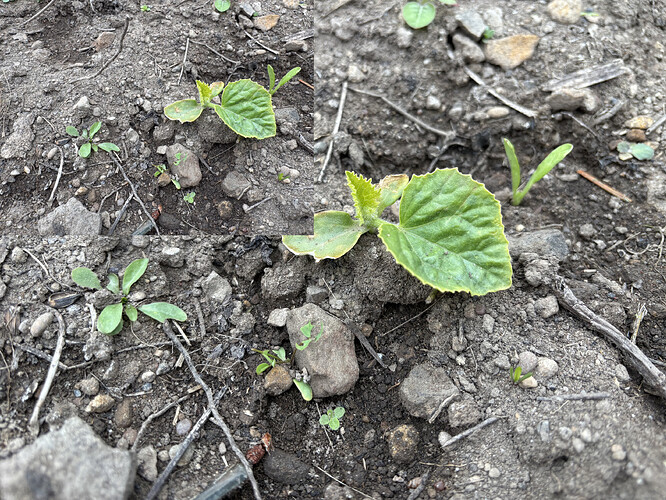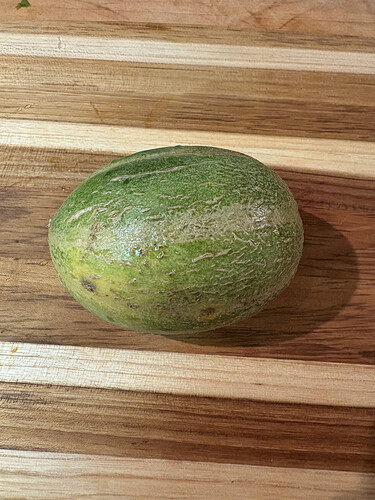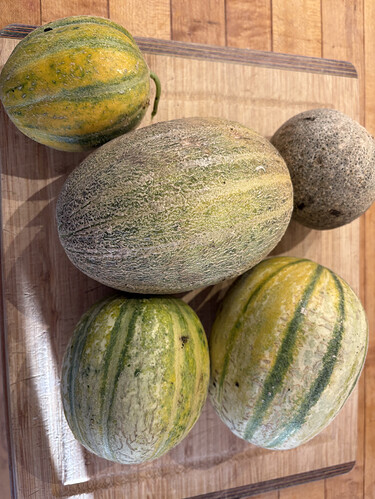Location Background: We are based on the Mendocino Coast in Northern Ca, where in the summer it rarely gets above 60 degrees and we receive lots of coastal fog. Temperatures year round are mild but cold, and farmers/gardeners struggle to grow warm weather crops. Greenhouses are needed for crops like tomatoes, peppers, eggplants, and other crops like melons typically aren’t even considered.
This will be the 2nd year growing out Melons (Cucumis Melo). Last year we chose to focus on melons because our cooler climate can be limiting for the types of produce people can access locally, especially for fruits. Diversity of foods is something we are excited about offering the community, and if farmers here are able to grow high value crops such as melons, it would be a benefit to many farm businesses. In addition to adapting this warmer weather crop to our cooler climate, we are also adapting it to our no-till, low input system so that when the seed is grown out by other farms it won’t require too many resources-- ideally no greenhouse, no heat mats, and minimal inputs (we will just use a little bit of compost). Last year we were growing the melons on our farm in Fort Bragg,. This year we will be growing them at the same site as the Cucurbita Pep project-- the Stanford Inn in Mendocino, as well as my home garden in Caspar-- both of which have very cool climates and similar to the farm last year. One challenge of this site is our soils which are high in sodium and boron, so we may have less success than at the farm last year, but perhaps it will give the chance for even hardier seeds. Last year we started seeds on May 7th which was too early and we had almost no germination, so this year we started them on June 6th.
This is a photo of the 100 square foot plot where I direct seeded the melons. The original plan was to DS 100 square feet and then TP 100 square feet in the area right behind the DS melons.
6/18/25 The first melons and pumpkins in flats emerging.
7/7/25
Melons at the stanford Inn in the bed starting to come up most small and yellow
Only 3 melons came up in the bed as you can see the flagged ones, and 24 came up in the flats. All of them were transplanted into the 100 sqaure foot area, but they didnt take up the whole space, and since there isnt enough for the original planned area, I will be incorporating seeds from my home garden (similar climate) into this mix. All pretty sad looking.
7/23/25 Melons at my home garden 50 square foot area
Melons at the Inn- the “healthiest ones” – not as much of a difference between DS and TPing for these ones so far.
The climate this year in mendocino has been particularly cold-- colder than last year, with most days being very foggy and few days of sun.
A few weeks after that last photo, all the melons at the Inn died– at the time I was not sure of the cause. So, I decided to transplant some of the melons from my home garden that were overcrowded, 2-3 plants growing in the same spot so I transplanted about 10 melons in place of these original ones that died. Unfortunately all of those were eaten– some slug damage, some deer. So now, the melon project is just taking place in my home garden.
This photo is from 8/11/25. You can see the melons are starting to fill out a bit more and are starting to flower.
9/25/25 the first of the melon fruits are starting to ripen.
10/3/25- the first ripe melon
10/6/25 some more ripen
10/14/25 some more
10/19/25 - lost one to an animal before we were able to get it. This was most of the melons, there are just a few left on the vines.
10/24/25 - vines are dying back and the melons are rushing to set fruit, some of which were falling off the vines (vines dying) before they were fully ripe. Of the ripe ones, most except for just a couple had a good flavor. While this years location is similar location to last years, last years location may have been sightly warmer allowing the melons to do a bit better.
Comparison to last year- less area due to crop failures at one of the melon planting sites which meant fewer melons and fewer good ones to save seed from overall, however from the ripe ones the flavor was good, so that is encouraging that the seed selection for flavor is going well and perhaps it’s stabilizing a bit. Seeds were started on June 6th, whereas last year the successful seeds were started on May 30th, with a second seeding on June 14th. Melons, especially in the cooler microclimate we now are growing in (as compared to last year) need as much time as possible to ripen, since I was noticing this year that the vines started dying back before some of the melons were fully ripe, so perhaps the one additional week would be important to utilize next year, or we could try starting seeds slightly earlier- last year we tried May 7th which was too early, but maybe we could try for mid-may or the third week of may to get an additional few weeks.












